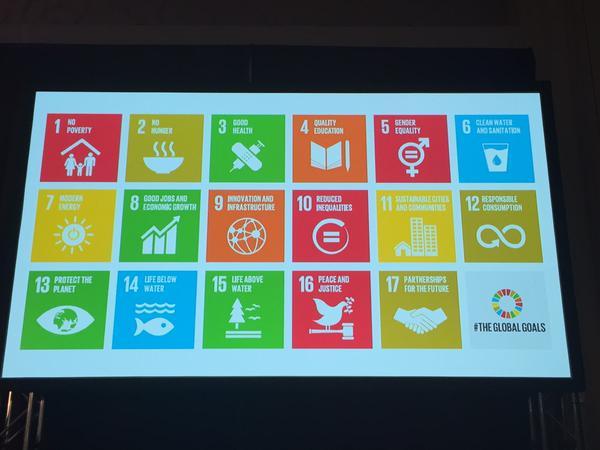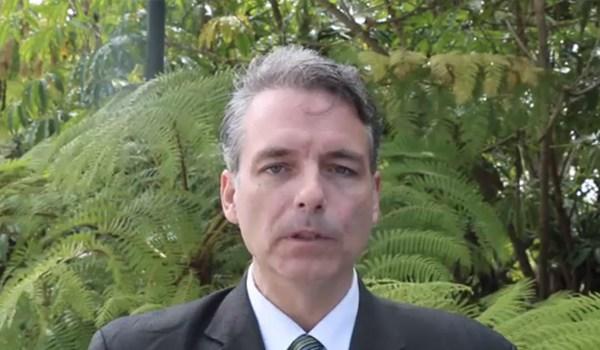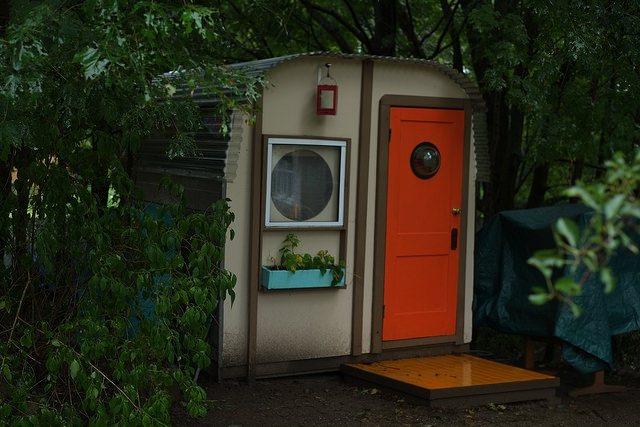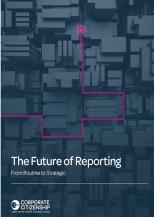The United Nations Invites You to 'Lever Up' Your Social Impact


By Christen Graham
I received a preview recently of the United Nations’ global goals for 2030, slated to be formally unveiled at their Social Good Summit in September. Presented by U.N. Foundation’s Aaron Sherinian at the annual Cause Marketing Forum, he laid out 17 (wow!) global goals.
Many of the corporations in attendance, like CVS, Seventh Generation and AT&T, are working on a good number of them – and issued a call for us all to “lever up.” Here they are:
- No Poverty
- No Hunger
- Good Health
- Quality Education
- Gender Equality
- Clean Water and Sanitation
- Modern Energy
- Good Jobs and Economic Growth
- Innovation and Infrastructure
- Reduced Inequalities
- Sustainable Cities and Communities
- Responsible Consumption
- Protect the Planet
- Life Below Water
- Life Above Water
- Peace and Justice
- Partnerships for the Future
Of course all businesses makes some kind of social impact, intentionally or not, positive or not. This list demonstrates (again) that a company’s social impact extends well beyond charitable giving and cause marketing, although those are excellent places to start.
Look inside and outside the four walls of your operations and think about the effect your business is having throughout the supply chain. Consider whether your business is practicing responsible consumption of water, as Pepsi and Coca Cola are doing now, or how it is performing on inequality vis-a-vis fair pay and executive diversity.
Companies that get it – Eileen Fisher, Unilever, IBM, Colgate Palmolive, Panera Bread and New Balance for instance – aren’t waiting to be regulated into thinking about these issues. These enterprises are working on all 17 in one way or another. And yet when asked what’s left to do, they will answer "still so much more."
Everyone is invited and eligible to participate in the Social Good Summit and can follow along at #2030NOW. And you don’t need to go to New York to benchmark the social impact your business has. Start a conversation with senior leadership to explore performance of these 17 points. The process will engage teams across the enterprise, connecting human resources, facilities and marketing. I guarantee (yes, guarantee) that once you do, your enterprise will make a greater positive social impact.
Christen Graham is President of Giving Strong, Inc. a global social impact consulting firm.
Collaboration key to 'sustainability crunch' says BIFM report


Businesses are finding it increasingly more difficult to implement and manage sustainability policies, according to research by the British Institute of Facilities Management (BIFM).
The annual BIFM Sustainability Survey, this year in collaboration with Cambium and Acclaro Advisory, explores how UK organisations are approaching sustainability, what the key drivers and barriers to their sustainability policies are, and how they could be improved.
The survey, now in its ninth year, reveals a 20% decline in confidence among businesses in their ability to implement and manage their environmental, sustainability and CSR policies compared to 2014. Despite sustainability pledges featuring within all of the political manifestos this year, the response from business appears muted says the BIFM, with 40% of respondents saying they thought their organisation was ‘very good’ or ‘excellent’ at implementing sustainability, compared to over half (60%) last year, and 43% in 2013.
The noticeable drop coincides with a reported increase in barriers to fulfilling sustainable practices. Physical constraints were highlighted by 80% of respondents, while financial constraints (71%) and a lack of organisational engagement (69%) were the next most commonly cited obstacles, requiring organisations to sharpen their focus and modify their sustainability strategies if they are to reap the benefits of long-term sustainable business practice.
The survey also found that over a third of respondents had no formal reporting system or data collection process when measuring effective sustainability outputs, resulting in a lack of evidence when it comes to building and reinforcing the business case of sustainability among leadership teams.
Gareth Tancred, ceo of BIFM commented: “Despite increased pressure on businesses to be more sustainable, we are actually seeing a decline in their ability to do so. What is clear from our findings is that organisations need to re-think their approach to sustainability in the face of increasing barriers. In nine years of conducting this survey, 2015 has seen the biggest year-on-year decrease recorded and historically, sustainability has been dominated by a tick-box mentality by business which is undermining the long-term value of sustainability investment.
“Whilst it is encouraging to see so many organisations regarding sustainability as an important part of their corporate agenda, businesses must adopt more formal processes to monitor and measure progress and avoid a short-termist view of sustainable business practice. What is needed to address the ‘sustainability crunch’ is more collaborative working, to look beyond purely environmental connotations such as energy consumption, climate change and waste management, and integrate policies aligned with societal sustainability, such as the Living Wage. The risk of not doing so is that organisations are accused of only paying lip service to sustainability.”
Download the full report here.
PLA's purrfect recycling initiative roars into life at big cat sanctuary


Lions and leopards at a big cat sanctuary are playing with ropes that just weeks before were being used to tie boats up on the Thames, in a new Port of London Authority (PLA) recycling initiative.
The recycling idea was launched as part of the PLA’s drive to make use of materials that would otherwise be thrown away.
Wildlife Heritage Foundation (WHF) collected the first two pallets of rope and lifting strops recently and they are now being used at the sanctuary’s ‘Enrichment’ enclosure as scratch posts, to keep cat claws sharp and their feline minds stimulated.
A 10-metre plastic pipe dumped in the Thames and salvaged by PLA staff will also be fashioned into play tunnels for meerkats at the WHF’s sister site in Hertfordshire.
PLA environment manager Tanya Ferry commented: “It’s really rewarding to know that something we’ve finished with has been given another lease of life. It helps reduce the waste we are producing, and cuts the Foundation’s spending on ropes, which can be expensive.”
Video: Paul Herman, HIP Investor on "The ROI of Sustainability"


This article is part of a series on “The ROI of Sustainability,” written with the support of MeterHero. MeterHero helps companies and organizations offset their water and energy footprints through consumer engagement. To follow along with the rest of the series, click here.
At Sustainable Brands 2015 we asked thought leaders to define the "ROI of Sustainability" in their words. In this video, Paul Herman of HIP Investor shares some thoughts:
https://youtu.be/tvGGck1FxCw
About Paul Herman:
R. Paul Herman created the HIP (Human Impact + Profit) methodology for entrepreneurs, companies and investors worldwide to realize how quantifiable sustainability can drive financial performance. Herman advises investors, designs HIP portfolios, and manages the HIP 100 Index -- all applying "The HIP Scorecard" featured in his 2010 book (The HIP Investor; Make Bigger Profits by Building a Better World; John Wiley & Sons), Fast Company magazine, business school curricula, and at www.HIPinvestor.com.
Making Renewable Energy Greener


The case for renewables is clear: Evidence shows that, even when including production, maintenance and tear-down costs, wind and solar energy are still significantly greener, in terms of greenhouse gas emissions (GHG), compared to fossil fuels. This is why news about growing solar and wind capacity in the United States and around the world is an unequivocal positive as we shift to a clean energy economy.
Of course that doesn't mean there aren't areas in which wind and solar could improve and become even more green. But to make clean energy greener, we need good, reliable data. That is what a new report published in the journal Energy Policy, entitled Assessing the Lifecycle Greenhouse Gas Emissions from Solar PV and Wind Energy: A Critical Meta-Survey, seeks to provide to renewable manufacturers and planners.
“[The report authors] examined more than 153 studies on the life-cycle CO2 emissions of a range of wind and solar photovoltaic (PV) technologies, and selected 41 for deeper analysis, allowing the scholars to better understand the emissions of current technologies as well as pinpoint where emissions occur and under what circumstances, and thus how they might be reduced. All the studies chosen for inclusion were peer-reviewed and more than 70 percent were published within the last five years,” the report reads.
Their findings were very interesting. For one things, the authors -- from Vermont Law School and Aarhus University -- found huge variation in GHG emissions. In wind farms, it ranged from 34.11 grams of CO2 per kilowatt-hour produced, to 364.8 grams, with solar seeing a similar rage (1 gram of CO2 to 218 grams CO2). This demonstrated a key point: While solar and wind are, in general, green, some technologies and methods are far more green than others.
Researchers also examined the various stages of a technology's lifespan, and found that the phase that could be most greened is what the authors called the “material cultivation and fabrication stage,” a fancy way of saying building and setting up. This alone was responsible for 71 percent of both solar and wind GHG emissions. A focused effort to bring this number down could really reduce the smaller, but significant, carbon footprint of renewable energy technologies.
Another key – building energy systems that last. The longer the lifespan of a wind or solar installation, the lower its GHG emissions. Thus, a greater up-front cost to build a more durable system could pay off huge carbon dividends in the long term.
“By spotlighting the lifecycle stages and physical characteristics of these technologies that are most responsible for emissions, improvements can be made to lower their carbon footprint,” the report concludes.
This is the right way forward. Let's not be satisfied with green for green's sake. Let's continue to study, gather data, and build better, more efficient, more carbon-neutral renewable energy systems.
Image Source: Pixabay
Autodesk Sustainability Report: “Here to Help More People Design a Better World”


Many companies today are taking actions to improve their environmental footprint and their social impact under the banner of corporate social responsibility. In order to share these actions, many are publishing sustainability reports, targeted at raters, rankers, investors and analysts, as well as the general public. Each company’s story is a little different. Some companies, like raw material suppliers or airlines, use massive amounts of energy or other resources in their operations. Their reports typically describes their targets, efforts and accomplishments in improving their internal efficiency. Others, like carmakers, produce products that consume large quantities of non-renewable fuels. Their reports generally focus primarily on improvements in product efficiency.
Autodesk is a little bit different. As a global provider of computer-aided design (CAD) tools, it provides the means by which their customers can design both facilities and products that can operate more cleanly and efficiently with a significantly smaller footprint.
I spoke with Ben Thompson, Autodesk’s senior sustainable business program manager, on the occasion of the release of its 2015 Sustainability Report, entitled, "Sustainability in Action."
“Autodesk’s core opportunity, when it comes to sustainability, is through the enabling capabilities that we have and through the influence that we have,” says Thompson, who has been with Autodesk for six years.
Those capabilities and that influence largely come through the software in which it they are embedded, though it seems to show in just about everything the company does these days.
TriplePundit: How would you characterize this year’s sustainability report?
Ben Thompson: The Sustainability Report is really our greatest hits. We cover everything from our operations, what we’re doing there and what we hope for the private sector to do; highlights of our latest sustainability solutions and our sustainability solutions micro-site, which includes solutions for building designers, infrastructure engineers and manufacturers. Because this is the first year of our foundation, we’re also going into our philanthropic efforts. (Note: For more on the Autodesk Foundation, including their support of clean-tech startups, see our interview with Lynelle Cameron here.)
3p: I see in the report that you’ve made the commitment to power the business with 100 percent renewable energy. That’s great! How does that fit into your overall strategy?
BT: On that front, we really think that this is going to be a transformative year for climate action. We really wanted to demonstrate to policy makers leading into COP21 in December that the private sector is onboard with an internationally-binding commitment that limits global temperature increase to 2 degrees Celsius. This commitment that we’re making is just us, as representatives of the private sector, doubling down and hoping to get more of our peers onboard as well.
3p: Do you think we’ll see a commitment in Paris?
BT: We believe we’re going to get a commitment in Paris. But we’re really looking at what’s going to happen after Paris.
3p: Because that’s when your work really begins...
BT: When it comes down to it, we’re making the solutions, and providing the design tools, that are going to make these commitments achievable. That’s really what it comes down to for us. Our little footprint doesn’t matter much compared to how we can influence other footprints.
3p: The EPA has designated Scope 1-3 for different emission sources, but it doesn’t track the emissions of customers using tools like yours. Is that something you track or have thought about tracking?
BT: It is something we’re thinking about. But we’re not interested in taking credit for things that our customers are able to create or invent on their own. But we do want to better understand the type of impact that we’re having.
3p: Do you think we are evolving in how we look at companies and their sustainability efforts?
BT: Moving forward, in many cases, it’s going to be the handprint rather than footprint. How do you make sustainability part of your business? How do you make it a service offering? How do you provide it to customers, not only to sustain your own business with revenue from those services, but also to create better environmental and social outcomes for your customers? Our sustainability solutions group has done a really great job of making sustainability core to our service offering. So, it’s going to be more positive — not just making less bad, but making more good.
3p: What products and features are you offering today that embody that? Can you give some examples?
BT: Our RevIt building solution is a Building Information Modeling (BIM) app. It allows users to simulate proposed modifications and see the impact on performance. We are also starting to incorporate Life Cycle Analysis (LCA) into tools like Tally.Tally enables Life Cycle Assessment (LCA) of materials used in buildings.
3p: What other accomplishments would you like to highlight in this year’s report?
BT: There is an infographic online that summarizes it. We hit our GHG reduction target of 27 percent right on the nose. Overall emissions from our facilities are down 65 percent over 2009. The science-based approach to emissions targeting called C-FACT, which we invented almost seven years ago, [not to be mistaken for the climate denial website CFACT.org] is getting really popular. [C-FACT enables companies to align their targets with goals from the Intergovernmental Panel on Climate Change, adjusted for GDP contribution, recalculated annually based on performance.]
3P: Last question: What is the thought that keeps you moving forward?
BT: If we’re trying to make a better world, how do we make a better Autodesk first? How do we get our business lined up right, how do we get our products, our employees doing more for sustainability?
Image courtesy of Autodesk
Tiny Houses Are Gaining a Footing in North American Cities


Tiny house communities have been gaining popularity in recent years, and it isn't hard to see why. The idea of being able to plunk down a house -- complete with a kitchen and basic amenities -- for less than the cost of a used car is almost irresistible.
I say almost because there's an obvious catch. You have to be able to live in a space that, in some cases, equals the square footage of a bedroom. You have to be frugal by nature, both in what you use and what you love. And it goes without saying that you have to be comfortable with yourself, and those with whom you share that miniature retreat at the back of your friend's yard.
But the tiny house industry is still booming. What initially began as a do-it-yourself construction project has morphed into a niche industry that is capable of supporting a single, independently-minded entrepreneur or the growing young family with a modest income.
Forty percent of unemployed workers were millennials in 2014. “That equates to 4.6 million unemployed millennials — 2 million long-term,” Marketwatch reports. And some 44 percent of college graduates that have managed to get jobs are employed in low-end positions with little hope of advancement. Most hold college degrees. So, places like Portland, Oregon, and Austin, Texas, where real estate is considered prime, are becoming favorite locations for that 500-square-foot mansion.
Research suggests that those states and cities that are experiencing the highest growth in tiny house communities are ones where either zoning and other bylaws are “tiny friendly,” or there are alternative settings in which to plant your house.
In Florida, some RV parks allow for tiny homes on an indefinite basis -- not really a surprise given Florida's reputation as a tourism destination. But most cities that have become niches for downsized homes are still trying to come to terms with the concept.
In Nelson, British Columbia, Canada, a city built at the foot of some of the province's most rugged mountains, the city bylaws had for years maintained a minimum width requirement of 15 feet for housing structures. In 2013, the city council admitted that with the increasing popularity of homes spanning as little as 10 feet in width, it would have to look at revising the bylaws. Nelson, like Vancouver, which is also wrestling with the concept of small versus million-dollar estates, has its own growing community of tiny aficionados that are working toward making tiny an accepted, sustainable concept.
With the ongoing growth of tiny house communities that can support and nurture a neighborhood in a quarter of the space of conventional communities, it's likely we'll see more of these miniature, less-conventional homes. If so, it will be interesting to see what adjunct industries spring from that growth, and their ability to meet the needs of an increasingly cost- and space-conscious consumer sector.
Image credits: 1) and 3) Tammy Strobel 2) Tomas Quinones 4) Nicolas Boullosa
Sustainability Reporting: From Routine to Strategic


By Nana Guar
When was the last time you read a truly interesting sustainability report? For many people working in corporate responsibility, the annual reporting process has become dull. The last 20 years has seen a massive explosion in the number of non-financial reports. But who actually reads them? What difference do they really make?
Sustainability reports, impact reports, corporate responsibility updates. Call them what you like. More and more organizations are producing them due to rising demands for transparency and accountability. Today, more than 10,000 companies produce some sort of account of their non-financial performance.
Many companies are also crying out for a more meaningful engagement with their stakeholders. That’s easier said than done. Does anyone actually read these reports? And what difference do they make for the organizations producing them?
I recently completed some in-depth research for the organization I work for, Corporate Citizenship, looking at the trends, challenges and solutions to the perilous state that reporting finds itself in. We interviewed practitioners from across the world. Everyone seems to agree that too many reports simply fail to create value for companies producing them. Something needs to change.
Confusion breeds failure
Reporting has become confusing and overwhelming for many. What’s the aim of the report? Who is it designed for? How do you choose what content to include and what to leave out? What data should be used? Which standards should be followed? What format should you publish in? How should you engage audiences? How can the report be ‘brought to life’? There’s a lot to consider.
Despite best efforts to make reporting engaging and relevant, frankly, for many companies the results are uninspiring. While practitioners recognize the importance of communication on sustainability performance, many find the reporting process challenging and often frustrating. The end result often fails to land the right messages with the right audiences, let alone create value and improvements for the reporting organization.
Is it all worth the effort?
It seems that for all the time and effort that goes into sustainability reporting, many organizations fail to extract maximum value. However, the growing number of reports suggest that the practice is here to stay. So, how can companies address these challenges and progress from dry, routine reports to more strategic and engaging communication?
Four key trends that are reshaping reporting emerged from our research. They point to some exciting opportunities ahead. These trends are evolving fast, and companies need to be aware and position themselves to take advantage of emerging opportunities if they want to get more value from the reporting process. We call these critical trends the Four Drivers of Change.
Four Drivers of Change
1. Strategic alignment: Closer alignment between sustainability and commercial decisions has become a business imperative.There is a heightened awareness of the impact that responsible and sustainable business practices can have on financial performance. This is about much more than reputation. Companies are seeking to demonstrate that integrating sustainability into their business can help with cost-efficiencies, risk management, creative innovation and long-term growth.
2. Issues expansion: The scope and significance of issues are expanding across extended value chains.
There are mounting social, environmental, ethical and economic challenges for companies right across their extended value chains. The scope of responsibilities has widened as companies are expected to be accountable for indirect impacts concerning their suppliers, distributors, contractors and business partners – on top of all the direct impacts the business already has.
3. Standards proliferation: There is a rapid proliferation of sustainability-related standards, rankings, ratings and indices.
These initiatives either offer guidance on reporting or rate companies’ performance based on set criteria. Each one serves a unique purpose and targets different audiences; but they sometimes have overlapping criteria or principles.
While responding to such initiatives is an opportunity to engage colleagues across the business, streamline data collection, and improve reporting and performance, making sense of it all can be overwhelming.
4. Digital innovation: Digital innovation offer new ways of presenting data and communicating with audiences.
Practitioners are increasingly facing demands for more data and narrative to a variety of audiences. This can result in lengthy, dry, technical reports that aren’t effective engagement tools. Innovations in digital platforms and social media allow companies to present data, narratives and impacts in ways that resonate with a variety of audiences; and audiences are able to interact, feedback and share opinions instantly. Technology-driven engagement also presents opportunities to connect with stakeholders across geographies, demographics, and varying interests in ground-breaking ways.
From routine to strategic
The dynamic, shifting landscape is causing headaches – but also throwing up some fascinating opportunities. Companies that are able to harness the Four Drivers of Change will create real value for the business and the audiences of its reporting. As reporting becomes increasingly interactive, innovative, and audience–led, the benefits will be most tangible for companies that are crystal clear about the first question: What is our objective?
Communicating about sustainability can be a minefield of nebulous jargon and opposing viewpoints. It is time for a re-think. We need to go back to basics and understand the reporting journey as well as the current trends that are creating pressures on the reporting process. Companies need to cut through the complexity and get back to shining a search light on what the company is actually doing and invite in friends and foes alike for a frank discussion about how they can do a better job. That would make reports a lot more interesting for everyone and more useful to businesses.
Image credit: Corporate Citizenship Inc.
Nana Guar is a Senior Consultant at Corporate Citizenship, a global management consultancy specializing in sustainability and corporate responsibility. She works with clients to identify their most material issues, define relevant performance metrics, and communicate their performance to a variety of audiences. When she is not immersed in sustainability reporting, reporting standards, CR strategy and implementation, Nana is applying her expertise to sustainability challenges in emerging markets.
New York City Plans the World’s First Underground Park


New York City, you’re at it again. Every other city in the U.S. was already jealous of your underground subway (especially LA), but now you’ve really outdone yourself. Five years ago you asked, “How can we build more green space in our cities?” Then you had a crazy idea. You decided the answer lay below your feet and ambitiously decided to build the world’s first (drumroll) … underground park. Amazing.
Then you asked an even crazier question, “What if the sun could shine underground?” And you figured out a way to give the underground park natural sunlight.
First came the High Line, a park in the sky. Now comes the Lowline, an underground park. The bottom line is: We are impressed. New York, is there anything you can’t do? Oh yeah, eliminate cockroaches. But still, we admire you.
The Lowline is a project that will transform an early 1900s underground trolley terminal into a luscious green park the size of a football field.
Creator and co-founder, James Ramsey, says, “The core feature of the Lowline is that we can take the sunlight, send it underground, and use that to grow stuff. With this natural sunlight, we can take an abandoned trolley terminal […] and transform it into a vibrant public place that is filled with plants and trees and create something unlike the world has ever seen.”
The project is being crowdfunded on Kickstarter. The goal is $200,000, and donations are currently around $87,000 with 14 days to go, so you still have time to open up your wallet and give a little green to create more green.
Dan Barasch, co-founder and executive director, explained during a TED Talk that walking through the old underground trolley station made him feel like Indiana Jones on an architectural dig, minus being chased by natives with blowguns.
Barasch was also fascinated by the area because his grandparents lived nearby when the trolley station was running. They were part of the generation that built up New York City. He used to ask his Italian grandma about that time period, but she just told him to eat more spaghetti and meatballs. Now he feels it’s his generation’s turn to build the city by turning abandoned areas into beautiful spaces for the community.
The entrance to the park will literally be a slab of peeled-back street, as if Godzilla had taken a peek at the trolley station. People will be able to step down underneath the layer of the modern world and walk into the history of the past. Oddly enough, they will simultaneously experience the future since modern technology will transform the underground with natural sunlight. Sunlight will be collected by mirrors and tubes will transport the sunlight underground.
Other cities have more green space than New York City. This particular area only has one-tenth the green space of other cities. Fortunately, the Lowline will be a four season park -- the warmth of the underground will make it useable during the cold winter.
Barasch reminisced, “I always knew as a kid that I wanted to make a difference. To somehow make the world more beautiful, more interesting and more just. I just didn’t really know how.” How many of us have said the same thing? He went through a slew of social impact jobs looking for the right fit.
First he worked for UNICEF in Kenya. Then for the U.S. government (yeah, you saw that disillusionment coming). Next he worked at Google because he was inspired by technology’s ability to solve some social problems. Finally, he found his purpose when he started a side project creating the Lowline. Then he did something crazy … he quit his job. That takes guts that most of us don’t have. But when you find your passion, you’ve got to burn your bridges and pursue it with your whole heart. Kudos to this guy for making his dream a reality.
Barasch is now sharing his childhood dream of making a difference with the children in the community. He created a Young Designers program which gives the kids a chance to help design the park. Robyn Shapiro, the Lowline director of community, says the “program is meant to engage local youth in designing and building their vision for what the future of the park could be. Some of the ideas were completely whimsical and fun.” One kid’s model included zip lines, tree houses and a skate park. Yes, please.
A young girl named Bryanna adorably expressed the significance of the park, “It’s important to build the Lowline so now we can have something down there instead of nothing.” Exactly.
Keep dreaming and changing the world, New York.
Image credits: Feature image by Steve Slater via Flickr; 1) The Lowline website; 2-4) Dan Barasch's TED Talk
6 Solutions to the Water Shortage Crisis


By Jon Wikstrom
California’s recent struggles with drought have been widely covered in the media of late. Everyone knows the situation there is dire.
But will this same dangerous crisis be repeated in other parts of the world?
NASA seems to think so. In a recent report, the agency pointed out that our world is running on the brink of a freshwater shortage. Giant lakes are disappearing, and the world is heading toward a future where many countries could be water insecure.
But when faced with a crisis, history shows us that humanity has an amazing ability to conquer it resourcefully, and that’s exactly what many environmental innovators are seeking to do by introducing new technology that helps businesses and individuals alike cut down on their water usage without compromising their quality of life.
1. Solar-powered water purifiers
Hot climates suffer from water shortage the most. This is what drove an American schoolgirl to come up with a way to use solar power to purify water. When she was just 15, Deepika Kurup invented a way to use zinc oxide and titanium dioxide in containers that expose it to ultraviolet radiation and cleanse the water, making it suitable to drink. She was on the Forbes' 2015 30-Under-30 in Energy list and was even awarded the U.S. Stockholm Junior Water Prize for her invention.
Her invention will help to address the fact that 1.1 billion people worldwide don’t have consistent access to clean drinking water. Using Kurup’s invention and others like it, people will be able to make contaminated water drinkable so that they don’t have to depend on outside sources.
2. Leak monitors
German utility company, Albstadtwerke, has been using new software to pinpoint leaks and send the data instantaneously to a central data center. Showers, toilets and dripping taps are known to waste water, but the biggest problem is originates from pipelines that lead into the home.
The company believes that almost a third of water is wasted even before it reaches a home. The software, Zonescan Alpha is helping utilities around the world crack down on this inefficiency and massive waste of precious resources.
3. CO2 cleaning
Water is used in many industrial applications, sometimes as a wet coolant or cleaning agent on a grand scale. Both of these activities lead to tons of waste every single year. To give you an idea of how much, manufacturing a car requires nearly 40,000 gallons of water – just imagine how that much water could benefit a community that’s experiencing a water shortage. Fortunately, technology that would allow for water to be replaced by CO2 has evolved enough to be viable in a wide variety of industries.
CO2 cleaning involves the use of carbon dioxide in solid form, highly propelled dry ice particles out of a nozzle to clean a variety of different surfaces. The technology can be used for composite aircraft and automotive structures, cleaning complex medical equipment, and dry cleaning operations in an eco-friendly way. The CO2 required for these machines is recycled from other industrial uses, so not only does it contribute to solving the water shortage crisis, but also helps with climate change. This is a great example of an environmental solution that kills two birds with one stone.
4. Lifesaver bottles
When the Boxing Day tsunami hit Asia a few years ago, trucks had to be sent in with drinkable water since the floodwater was simply too dirty. This led Michael Pritchard to invent a special bottle that can instantly make water potable. It uses a pump to push the water through a 15-nanometer filter which cleans it of any bacteria or viruses.
Everyone from hikers to the British army has used it since. In that time it has not only given hundreds of thousands of people clean drinking water, but it’s done so without the financial or environmental costs of delivering water to the places that need them most.
5. Showering with ultra efficiency
We’ve all gotten into a shower, turned on the tap and waited for the water temperature to be just right before we get in. The problem, according to Richard Ogodeton, is that hundreds of millions of people do this every day around the world. In aggregate, this is a lot of water wasted. To save this water Ogodeton invented an eco-friendly shower system, which can have the water to the desired temperature in less than 30 seconds, significantly cutting down shower time and reducing water wastage.
Another innovation in shower technology is from Peter Cullin in Adelaide, Australia. He came up with a device that could save hundreds of millions of liters of water every year, even if it were installed in only 1,000 homes. He calls his device the Cullector Ultra Efficient Shower, which uses a reservoir tank to collect the water normally wasted during heating up the shower, then re-filters it back at the right temperature. These ideas and more show promise in limiting water usage to better our current environment.
6. Showering without water
Can you shower without using water at all? It doesn’t even seem like a genuine question until you really look into the alternatives. That’s exactly what 17-year-old Ludwick Marishane did while traveling in Limpopo, South Africa. He found all the ingredients for a ‘dry bath’ on his Nokia 6234 mobile phone. His lotion has a blend of chemicals that get rid of odors, bioflavonoids and essential oils. The lotion can be applied right onto the skin and is as effective as taking a regular shower.
Dry Bathing can help save 4 liters of water per person which can add up to many millions every single year and help billions of people who don’t have access to water stay clean and avoid the life-threatening bacteria that’s often found in the stagnant water some of these people use to bathe.
Many experts estimate that we use over 9 trillion cubic meters of water every year as a species. The demand for water will only grow as the global population continues to expand at an increasing pace.
Water is an already-previous resource that becomes even more precious with every passing day.
The recent water crisis in California has put the spotlight on water usage but the fact is that billions of people around the world live in regions where they are forced to walk for miles to get their daily supply for drinking, bathing and living and some aren’t even that lucky.
In the coming years, it will take creative solutions like these to help our world continue to thrive in the face of this global challenge.
Image credit: Flickr/gedenfield
Jon Wikstrom is the founder & CEO of Cool Clean technologies, one of the leaders in the eco-friendly technology of liquid CO2 cleaning. He also enjoys sharing his knowledge and passion for green technology as a guest blogger on a variety of manufacturing & environmental blogs. To learn more, check out http://www.coolClean.com.